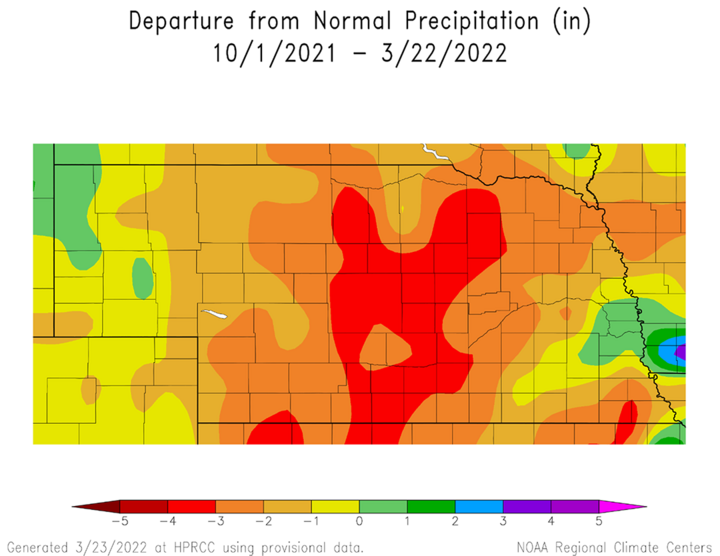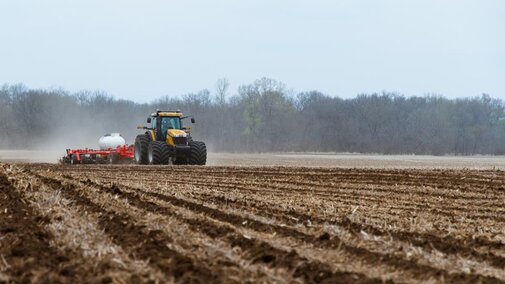For much of Nebraska, fall 2021 to spring 2022 precipitation has been below normal (Figure 1), providing some of the good field conditions for pre-plant fertilizer nitrogen applications. Good field conditions are appreciated, but there are still considerations that justify shifting more nitrogen application to in-season versus pre-plant.
One concern is N loss when fertilizer-N is not incorporated. Fertilizers containing urea (such as dry urea and liquid UAN) need to be either injected, incorporated into the soil, or have a half inch of precipitation or irrigation to move them into the soil to stop ammonia volatilization. While urease inhibitors can help provide protection against volatilization, water is eventually needed to stop loss for surface-applied N.
You may wonder how much ammonia volatilization loss can occur with surface-applied fertilizer-N. Unfortunately, N loss through ammonia volatilization is difficult to predict or easily quantify, but it is greater with the following conditions: high soil pH, low cation exchange capacity, more surface crop residues, wet soil, insufficient rainfall, high temperature and higher N rates.
In addition to volatilization, N loss may also occur due to leaching of nitrate with heavy precipitation and denitrification with soil water-logging, which may have localized occurrence this spring. Another disadvantage of applying all N pre-plant is that we can’t adjust for differences in actual nitrogen availability. For instance, actual N availability may also be less than expected if the release of manure N is lower than expected or if uptake of N by a cover crop and N immobilization by cover crop residue is more than expected.
To account for this variability and reduce losses, consider applying more of your fertilizer-N in season. The amount of fertilizer-N to be applied in-season can be estimated with the Late Spring Soil Nitrate Test (LSNT, also called the Pre-sidedress Soil Nitrate Test or PSNT) or by use of crop canopy reflectance sensing. This article addresses these options as well as fertigation and variable rate applications. In addition to LSNT and crop canopy reflectance sensing, there are models to predict N needs, but these are not addressed in this article.

Late Spring Soil Nitrate Test
The LSNT has been available for over 30 years and is used for corn production to assess the need for in-season N application. It has been less studied and used in Nebraska than in Iowa and we advise use of the Iowa State University guidelines: Use of the Late-Spring Soil Nitrate Test in Iowa Corn Production. The LSNT has been well-validated for medium and fine texture soils, but it is not expected to work well for sandy soil. Use this test as follows.
- Collect a representative soil sample from the 0-12 inch depth when the height from the ground to the top of the corn plant whorl is six to 12 inches. The area represented by a sample should not be more than 40 acres with sampling zones defined according to soil properties likely to affect N availability or loss. Each sample should be made from at least 15 cores and more in cases of past manure injection. Avoid sampling in bands of fertilizer-N application. Samples should be collected at varying distances from corn rows. For example, three samples of varying distance from the row might be sampled at five sites for the management zone.
- Refrigerate the samples or air-dry them in a thin layer on sheets of paper, or with the assistance of a fan. Alternatively, submit the sample so the analysis can be done within three days.
- The laboratory analysis needs to be for nitrate-N only.
- The critical value for a normal spring, as assumed in 2022, is 25 ppm nitrate-N.
- If nitrate-N is above the critical level, for example 27 ppm in 2022, do not apply in-season fertilizer-N.
- If nitrate-N is below the critical level, apply 8 lb of N for each ppm below the critical level.
For example, if LSNT results are 15 ppm nitrate-N, the N rate = (25 - 15) x 8 = 80 lb/ac N.
See the ISU publication "Use of the Late-Spring Soil Nitrate Test in Iowa Corn Production" for more discussion of LSNT considerations, such as for fields with manure application.
Sensor-Guided In-Season N Application
Remote sensing of the crop canopy reflectance is the best option to quantify the need for in-season N if the plants are large enough. The remote sensing can be:
- with a handheld sensor, such as with the made-in-Lincoln Rapid Scan,
- with aerial sensing (drones, planes, satellite), or
- with sensors fitted on high-clearance N application equipment.
Such remote sensing requires good canopy development such as the eighth leaf stage (V8; or with 10 horizontal/droopy leaves) or later. Remote sensing is best done with a reflectance index such as NDVI (normalized difference vegetative index); however, with corn, the NDRE index (normalized difference red edge) is preferred.
The crop N status for any given part of the field is determined by relating the NDRE for that part of the field with high NDRE readings from the field. The high NDRE readings are often from established “High N Reference” areas or strips in the field. These areas can be small, such as 20 by 20 feet, with hand application of extra fertilizer-N, for example at a rate of 1 lb of urea per 100 sq ft. Data from sensor readings for other parts of the field are then compared to the high N reference with the ratio of the sensor reading from the field divided by the sensor reading from the high N reference equal to a “sufficiency index.”
Sufficiency Index (SI) = (target area NDRE / reference NDRE)
Mathematical algorithms developed for corn in Nebraska are used to convert the SI value to an N rate.
- The Solari algorithm is relatively simple and requires only the SI value:
In-season N rate = 317 x the square root (0.97 – SI)
- The Holland-Schepers algorithm requires additional information and determines the N rate from the shape of a typical yield response function and the optimum N rate for the yield goal established by the producer. Producers provide this “optimum N rate” unless the economic optimum N rate is available. The Holland-Schepers algorithm also accounts for N credits such as due to the previous crop, manure application and nitrate-N applied in irrigation water.
The sensor-directed in-season N application is commonly done near the 12-leaf stage (V12 or with 13.5 horizontal or droopy leaves) of corn to correspond to a high rate of N uptake. The algorithms for calculation of in-season N rate are best calibrated for this growth stage. Early use is more likely to underestimate N need.
Fertigation
Fertigation is a common and cost-effective means of in-season N fertilization in Nebraska. As above, the use of LSNT, spot-checking of a field with a handheld sensor, or use of imagery (from drones, aircraft or satellites) can help determine if N should be applied by fertigation — that is, if the sufficiency index (SI) is less than 0.95. If needed, 30 to 40 lb/ac N can be uniformly applied. The N need can be reassessed two weeks later using sensor information to determine whether an additional application of 30 to 40 lb/ac N is needed. This procedure can be repeated with the last application no later than the R3 (milk) growth stage.
Should In-season N be Applied and is Variable Rate Application Justified?
As written above, LSNT or canopy sensing, with calculation of the SI, is used to determine if and how much in-season N application is needed. If the results indicate much variation in N need across the field, the N rate might be varied. Three options can be considered for variable rate application.
- This is most easily done on a management zone basis using LSNT or remote sensing.
- Aerial imagery can be used to develop a prescription map for application with high-clearance variable rate equipment.
- The crop canopy reflection can be sensed and the N rate determined on-the-go, with continuous adjustment of the N rate with properly-equipped high-clearance equipment.
Summary
Given below normal fall 2021 to spring 2022 precipitation, most areas in Nebraska are likely to not have had significant N losses to already applied N. However, N losses could be possible if soil conditions were not favorable at the time of N application or if heavy precipitation events occur in the next few weeks. Use of in-season N could mitigate N losses and promote a more efficient use of N. The in-season fertilizer-N rate can be determined using LSNT soil sample analysis for younger corn. Remote sensing can be used once the crop canopy is full enough to determine N need. The remote sensing information can also be used for flat and variable rate application. Period remote sensing also can be used to determine if additional fertigation of N is needed.
Dive in More with These Other CropWatch Articles:
- Now is the Time to Use the Nutrients You are Banking in Your Soils
- Does Your Corn Need Added Nitrogen? On-farm Research can Help Evaluate That
- Precision N On-Farm Research Project
- Effects on Profitability and Nitrogen Loss from Reducing N Rate for Corn
- Profit and Nitrogen Use Efficiency Gain Using Sensor-Guided Fertigation

